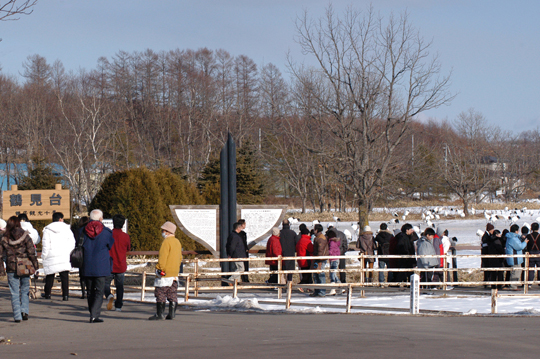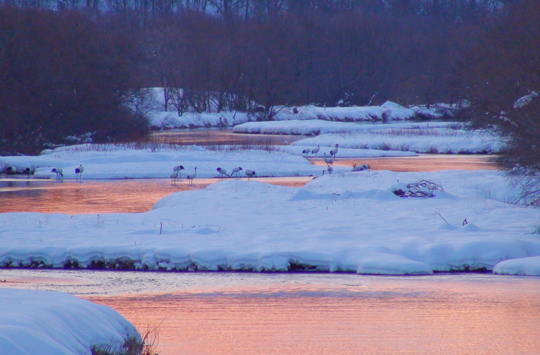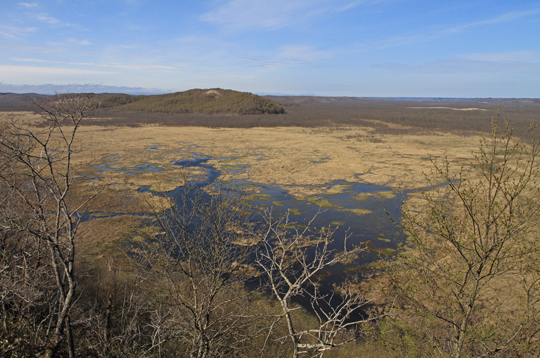
One can enjoy birding in relatively good environment around the sanctuary and in eastern Hokkaido in general. About 165 species of birds have been recorded in the Village of Tsurui, and about 230 species has been recorded in the City of Kushiro.
The red-crowned crane is one the biggest birds in Japan at 140-150 cm in height with wingspan of 220-240 cm. The plumage is mostly white with black in face, neck and parts of wings. Skin is exposed on the crown and is red. The red color becomes brighter when a bird is excited. The Japanese name of the species (Tancho) is derived from the red crown (tan = red & cho = crown). Indigenous people of Hokkaido, the Aynu, think that spirits inhabited in all creatures. They called the red-crowned crane ‘saruronkamui’ which means the ‘god of wetland’.
The Japanese population of red-crowned cranes is found only in Hokkaido, and there the cranes can be seen throughout the year. The population was thought to have become extinct about 100 years ago, but a small number of individuals was rediscovered in Kushiro Wetland in 1924. The current population size is unknown, but there are at least 1800 individuals. The red-crowned crane is omnivorous and feeds on fish, frogs, crayfish, shellfish, insects, earthworms, small birds, voles, snakes, as well as roots, new shoots and seeds of plants.
A large eagle with the wingspan of 220 ? 245 cm. This species breeds along the coast of the Okhotsk Sea and winters in northern Japan and Korean Peninsula. Eastern Hokkaido is probably the easiest place to see this species. The eagles are found near the coast, rivers and lakes with open water, and sometimes away from water where there is a deer carcass.
The white-tailed sea eagle is slightly smaller than the Steller’s sea eagle. This species is widely distributed across the Eurasian Continent. More than 150 pairs breed in Hokkaido, and the residents are joined by individuals from north-eastern Eurasia in winter. White-tailed sea eagles and Steller’s sea eagle are often seen together.
A pigeon-sized shorebird (wader) that breeds in grasslands in northern Japan and north-eastern Russia and winters in Australasia. In early summer, this species can be heard more often than seen. Around dawn, in early evenings, and on cloudy or foggy days, male snipes fly over their territories calling ‘zubiyahk, zubiyahk, …’ and making a roaring sound of ‘za-za-za-za-za-za-za-zah” with outer tail feathers during the descending part of the display flight. This species was once widespread and abundant in hay fields in eastern Hokkaido. However, as the timing of hay harvest has moved forward in recent years, the species has become much less common.
A sparrow-sized songbird that breeds in far eastern Asia. In eastern Hokkaido, it is a common breeder in a range of open habitat with some shrub cover. It sings with a whistle-like soft call ‘pi, pi, pippo-pippo’.
A small greyish songbird that occurs from cooler parts of Europe to East Asia. In Japan, this species is found only in Hokkaido but is a common resident there. It often forms mixed species flocks with other species of small birds during the non-breeding season.
A pigeon-sized woodpecker that occurs from Europe to East Asia. In Japan, this species is found only in Hokkaido where it is an uncommon resident. It often feeds on the ground, and a common way of noticing this species is when a bird is flushed out of the roadside vegetation while one is walking or driving.

This is another major feeding station for the red-crowned crane. It is located on a main tourist drive from Kushiro to popular spa resorts in Teshikaga and in Akan-ko. An elementary school was originally located at the site, and the students started feeding the cranes in winter. After the school was closed, Mr. and Mrs. WATANABE from a nearby dairy farm continued the feeding. Feeding takes place between mid- to late November and March (the same period as in the sanctuary). Up to about 300 cranes may gather at the time of feeding (currently once a day at about 9:00) from mid-December to January. There is no visitor center, but there are car parks, a kiosk/restaurant, and public toilet.

This is the only place where people can observe cranes roosting. A flock of up to about 200 cranes can be seen about 200 m downstream from the bridge between mid-October and late March. The cranes take off sometime after sunrise, and some cranes fly straight towards and over the onlookers. On cold mornings, trees along the river are covered in frost and steam rises up slowly from the river. With the first light of the morning, the frost and steam glow in ever changing shades of soft pink, and the roosting cranes can be seen through the rising mist. Photographers from around the world gather here before dawn (in temperatures of -20°C or below) in a hope to capture the ethereal moment. There is a purpose-built foot bridge for the photographers. There are car parks and public toilet, but there is no kiosk or visitor center.

This is one of a few places where one can actually experience walking in Kushiro Wetland. It is located just off a main tourist drive from Kushiro to popular spa resorts in Teshikaga and in Akan-ko. The visitor center is located about 5 minute walk from a large car park on the tourist drive. There is a system of boardwalks originating from the visitor center. The walk takes visitors through the wooded wetland, open wetland, sphagnum bog, woodland, and back to the visitor center. On the walk in summer, one may find a number of species of wetland birds (such as Siberian rubythroat, black-browed reed-warbler, and Middendorf’s grasshopper-warbler) as well as woodland birds (such as Japanese pygmy woodpecker, great spotted woodpecker, black-faced bunting, bush warbler, pale-legged and crowned leaf-warblers, brown robin, brown and narcissus flycatchers, Japanese grosbeak, and long-tailed rose finch). From mid-May to mid-August, one can also enjoy wildflowers. Information about the wetland as well as animals and plants are displayed along the walk. The visitor center is open throughout the year except on every Tuesday, and in winter, one can walk on snow-covered wetland with a pair or rental snowshoe. There is no kiosk at the visitor center.
There is one of WBSJ reserves near Onnenai. A pair of red-crowned cranes nests in the reserve. There is no access to the reserve.

There is an unpaved road cutting diagonally across the north-eastern part of Kushiro Wetland. One can reach the northern end of the unpaved road from the sanctuary by paved road through wooded hills and a dairy region. There is an observation deck on a small hill at the northern end of the unpaved road. From late March to mid-October, one may be lucky enough to see a few pairs of red-crowned cranes in their breeding habitat. Driving or walking along the unpaved road, one may find birds such as common and Oriental cuckoos, Siberian rubythroat, long-tailed rose finch, and reed bunting in summer as well as white-tailed and Steller’s sea eagles, siskin, common redpolls, and northern raven in winter. The unpaved road ends at Lake Tohro. There are public toilet below the observation deck, but there is no kiosk.

The three lakes are located along the main road from Kushiro to Shibecha (and onwards to Teshikaga and Sea of Okhotsk). These lakes are good places to look for waterfowl in spring and fall. One may see whooper swan, bean goose, goosander (common merganser), smew, common goldeneye, tufted duck, falcated duck, Eurasian widgeon green-winged teal, mallard, European coot, grey heron, white-tailed and Steller’s sea eagle, and black kite. There is a visitor center at Lake Tohro. There is no kiosk at the visitor center. One may also see a number of species of woodland birds by just walking around the visitor center. Further down the road from Lake Takkobu, there is an observation platform overlooking Kushiro Wetland and the view of meandering Kushiro River and mountains to the north of the wetland. From the observation platform, one may be able to spot a few pairs of red-crowned cranes in the wetland.